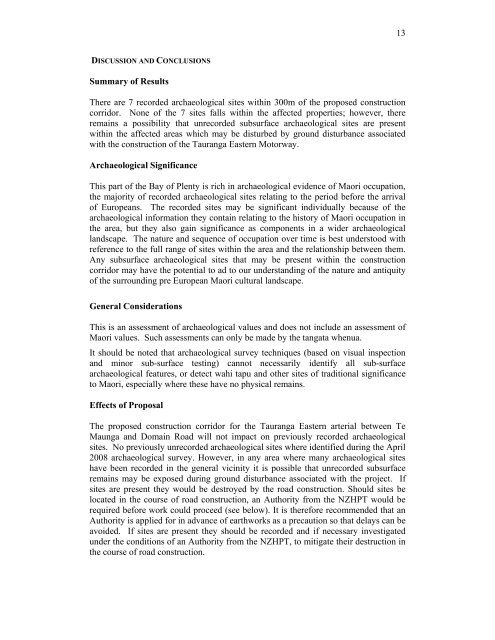2. Mangatawa catchment consents for earthworks, storm water ...
2. Mangatawa catchment consents for earthworks, storm water ...
2. Mangatawa catchment consents for earthworks, storm water ...
- No tags were found...
You also want an ePaper? Increase the reach of your titles
YUMPU automatically turns print PDFs into web optimized ePapers that Google loves.
13<br />
DISCUSSION AND CONCLUSIONS<br />
Summary of Results<br />
There are 7 recorded archaeological sites within 300m of the proposed construction<br />
corridor. None of the 7 sites falls within the affected properties; however, there<br />
remains a possibility that unrecorded subsurface archaeological sites are present<br />
within the affected areas which may be disturbed by ground disturbance associated<br />
with the construction of the Tauranga Eastern Motorway.<br />
Archaeological Significance<br />
This part of the Bay of Plenty is rich in archaeological evidence of Maori occupation,<br />
the majority of recorded archaeological sites relating to the period be<strong>for</strong>e the arrival<br />
of Europeans. The recorded sites may be significant individually because of the<br />
archaeological in<strong>for</strong>mation they contain relating to the history of Maori occupation in<br />
the area, but they also gain significance as components in a wider archaeological<br />
landscape. The nature and sequence of occupation over time is best understood with<br />
reference to the full range of sites within the area and the relationship between them.<br />
Any subsurface archaeological sites that may be present within the construction<br />
corridor may have the potential to ad to our understanding of the nature and antiquity<br />
of the surrounding pre European Maori cultural landscape.<br />
General Considerations<br />
This is an assessment of archaeological values and does not include an assessment of<br />
Maori values. Such assessments can only be made by the tangata whenua.<br />
It should be noted that archaeological survey techniques (based on visual inspection<br />
and minor sub-surface testing) cannot necessarily identify all sub-surface<br />
archaeological features, or detect wahi tapu and other sites of traditional significance<br />
to Maori, especially where these have no physical remains.<br />
Effects of Proposal<br />
The proposed construction corridor <strong>for</strong> the Tauranga Eastern arterial between Te<br />
Maunga and Domain Road will not impact on previously recorded archaeological<br />
sites. No previously unrecorded archaeological sites where identified during the April<br />
2008 archaeological survey. However, in any area where many archaeological sites<br />
have been recorded in the general vicinity it is possible that unrecorded subsurface<br />
remains may be exposed during ground disturbance associated with the project. If<br />
sites are present they would be destroyed by the road construction. Should sites be<br />
located in the course of road construction, an Authority from the NZHPT would be<br />
required be<strong>for</strong>e work could proceed (see below). It is there<strong>for</strong>e recommended that an<br />
Authority is applied <strong>for</strong> in advance of <strong>earthworks</strong> as a precaution so that delays can be<br />
avoided. If sites are present they should be recorded and if necessary investigated<br />
under the conditions of an Authority from the NZHPT, to mitigate their destruction in<br />
the course of road construction.
















